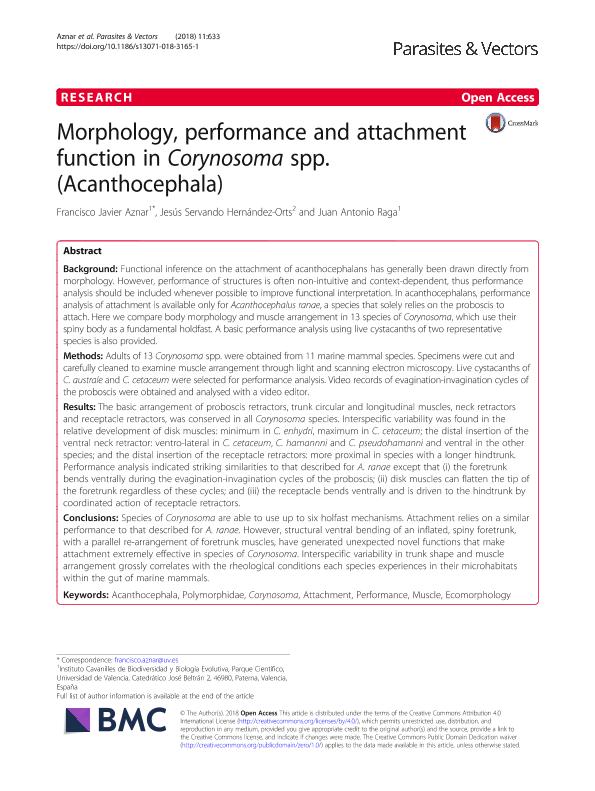Mostrar el registro sencillo del ítem
dc.contributor.author
Aznar Avendaño, Francisco Javier

dc.contributor.author
Hernández Orts, Jesús Servando

dc.contributor.author
Raga, Juan Antonio
dc.date.available
2020-02-20T19:05:12Z
dc.date.issued
2018-12
dc.identifier.citation
Aznar Avendaño, Francisco Javier; Hernández Orts, Jesús Servando; Raga, Juan Antonio; Morphology, performance and attachment function in Corynosoma spp. (Acanthocephala); BioMed Central; Parasites and Vectors; 11; 633; 12-2018; 1-11
dc.identifier.issn
1756-3305
dc.identifier.uri
http://hdl.handle.net/11336/98156
dc.description.abstract
Background: Functional inference on the attachment of acanthocephalans has generally been drawn directly from morphology. However, performance of structures is often non-intuitive and context-dependent, thus performance analysis should be included whenever possible to improve functional interpretation. In acanthocephalans, performance analysis of attachment is available only for Acanthocephalus ranae, a species that solely relies on the proboscis to attach. Here we compare body morphology and muscle arrangement in 13 species of Corynosoma, which use their spiny body as a fundamental holdfast. A basic performance analysis using live cystacanths of two representative species is also provided. Methods: Adults of 13 Corynosoma spp. were obtained from 11 marine mammal species. Specimens were cut and carefully cleaned to examine muscle arrangement through light and scanning electron microscopy. Live cystacanths of C. australe and C. cetaceum were selected for performance analysis. Video records of evagination-invagination cycles of the proboscis were obtained and analysed with a video editor. Results: The basic arrangement of proboscis retractors, trunk circular and longitudinal muscles, neck retractors and receptacle retractors, was conserved in all Corynosoma species. Interspecific variability was found in the relative development of disk muscles: minimum in C. enhydri, maximum in C. cetaceum; the distal insertion of the ventral neck retractor: ventro-lateral in C. cetaceum, C. hamannni and C. pseudohamanni and ventral in the other species; and the distal insertion of the receptacle retractors: more proximal in species with a longer hindtrunk. Performance analysis indicated striking similarities to that described for A. ranae except that (i) the foretrunk bends ventrally during the evagination-invagination cycles of the proboscis; (ii) disk muscles can flatten the tip of the foretrunk regardless of these cycles; and (iii) the receptacle bends ventrally and is driven to the hindtrunk by coordinated action of receptacle retractors. Conclusions: Species of Corynosoma are able to use up to six holfast mechanisms. Attachment relies on a similar performance to that described for A. ranae. However, structural ventral bending of an inflated, spiny foretrunk, with a parallel re-arrangement of foretrunk muscles, have generated unexpected novel functions that make attachment extremely effective in species of Corynosoma. Interspecific variability in trunk shape and muscle arrangement grossly correlates with the rheological conditions each species experiences in their microhabitats within the gut of marine mammals.
dc.format
application/pdf
dc.language.iso
eng
dc.publisher
BioMed Central

dc.rights
info:eu-repo/semantics/openAccess
dc.rights.uri
https://creativecommons.org/licenses/by-nc-sa/2.5/ar/
dc.subject
ACANTHOCEPHALA
dc.subject
ATTACHMENT
dc.subject
CORYNOSOMA
dc.subject
ECOMORPHOLOGY
dc.subject
MUSCLE
dc.subject
PERFORMANCE
dc.subject
POLYMORPHIDAE
dc.subject.classification
Zoología, Ornitología, Entomología, Etología

dc.subject.classification
Ciencias Biológicas

dc.subject.classification
CIENCIAS NATURALES Y EXACTAS

dc.title
Morphology, performance and attachment function in Corynosoma spp. (Acanthocephala)
dc.type
info:eu-repo/semantics/article
dc.type
info:ar-repo/semantics/artículo
dc.type
info:eu-repo/semantics/publishedVersion
dc.date.updated
2020-02-18T16:09:09Z
dc.journal.volume
11
dc.journal.number
633
dc.journal.pagination
1-11
dc.journal.pais
Reino Unido

dc.journal.ciudad
Londres
dc.description.fil
Fil: Aznar Avendaño, Francisco Javier. Universidad de Valencia; España
dc.description.fil
Fil: Hernández Orts, Jesús Servando. Universidad Nacional del Comahue. Centro de Investigación Aplicada y Transferencia Tecnológica en Recursos Marinos "Almirante Storni". - Provincia de Río Negro. Ministerio de Agricultura, Ganadería y Pesca. Centro de Investigación Aplicada y Transferencia Tecnológica en Recursos Marinos "Almirante Storni". Consejo Nacional de Investigaciones Científicas y Técnicas. Centro Científico Tecnológico Conicet Centro Nacional Patagónico. Centro de Investigación Aplicada y Transferencia Tecnológica en Recursos Marinos "Almirante Storni"; Argentina
dc.description.fil
Fil: Raga, Juan Antonio. Universidad de Valencia; España
dc.journal.title
Parasites and Vectors

dc.relation.alternativeid
info:eu-repo/semantics/altIdentifier/url/https://parasitesandvectors.biomedcentral.com/articles/10.1186/s13071-018-3165-1
dc.relation.alternativeid
info:eu-repo/semantics/altIdentifier/doi/http://dx.doi.org/10.1186/s13071-018-3165-1
Archivos asociados
